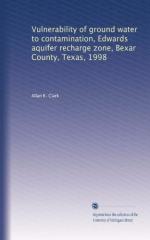|
This section contains 839 words (approx. 3 pages at 300 words per page) |

|
An aquifer is water-saturated geological layer that easily releases water to wells or springs for use as a water supply. Also called ground water reservoirs or water-bearing formations, aquifers are created and replenished when excess precipitation (rain and snowfall) is held in the soil. This water is not released through runoff nor is removed by the surface flows of rivers or streams. Plants have used what they need (transpiration) and little is evaporated from non-living surfaces, such as soil. The remaining excess water slowly percolates downward through the soil and through the air spaces and cracks of the surface overburden of rocks into the bedrock. As water collects in this saturated area or recharge zone, it becomes groundwater. The uppermost level of the saturated area is called the water table.
Groundwater is especially abundant in humid areas where the overburden is relatively thick and the bedrock...
|
This section contains 839 words (approx. 3 pages at 300 words per page) |

|


